What is life really like in North Korea?
Inside the Hermit Kingdom: Travels in North Korea

Last year, as few as 4,000 tourists from the West travelled to the Democratic People’s Republic of Korea (DPRK) - a number that is likely to drop off dramatically as political tensions rise between North Korea and the USA.
What makes this country so different to others? And what do tourists experience when they go there? Bringing together archive from a rich vein of programmes recorded for BBC Radio 4 over the last 15 years, including interviews with those who have visited, the documentary, Travels in North Korea - presented by Sara Jane Hall - provides a glimpse inside this secretive society. As tempers flare and threats fly, we take a tour inside the Hermit Kingdom…
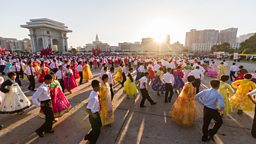
Entering the country by air
A Korean-American journalist recalls her journey to Pyongyang in 2016, flying with Air Koryo – North Korea’s only airline. There were little screens playing non-stop footage of the Moranbong band – an all-female group whose performers are chosen by the supreme leader. “All the songs are very ideologically heavy”, and praise the greatness of the regime. Propaganda is in evidence before you even step foot in the country.
On landing, the passengers’ luggage was checked for forbidden items: bibles, religious trinkets, magazines, and photos on phones or laptops. She was surprised to see how gleaming the airport was: “it’s actually very clean and organised and everything is brightly lit.”

Crossing into the country by land
In 2004, BBC Radio 4 followed a group of travellers into the DPRK on an overnight train journey from Beijing. Their first impressions were quite different…
There was almost complete silence because there was no traffic…
Kept in a hotel while their onward paperwork was arranged, the travellers described feeling like animals in a zoo: “We were sort of bumped off the train and landed in this border town…. We stayed in this hotel… I remember walking to the gates and the fence of the hotel and looking at the people walking past. What shocked me most I think was when we tried to wave at them or have any contact – they just kept their eyes ahead of them and pretended we weren’t there.”
Another noticed that “there was almost complete silence because there was no traffic… People walked everywhere and there were weird soft footfalls as people walked because they didn’t have leather shoes, they had some kind of cloth shoes and they just kind of padded past.”
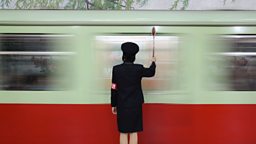
Pyongyang’s premier hotel
The Yanggakdo International Hotel sits on the Yanggak Island in the river Taedong. Touted as the capital’s best, world-class hotel, it is where many visitors stay on their trip to the city. It is 170 metres high, has opulent décor throughout, and a revolving restaurant on the 47th floor.
But for many, the grandeur of the hotel represents the gap between the reality of everyday life for civilians, and what the regime want to present to Westerners. One visitor recalls how, due to the shortage of electricity, only one elevator out of the bank of lifts would work, most of the lightbulbs had been taken out, and everything was dark: “The lights in our hotel room were so weak we wore head torches just to move around the room… And from quite a high floor on the hotel we looked out over the city and it was almost completely dark – there were hardly any street lights, there was very little traffic – it was weirdly silent. ”

What’s on the box?
Guests are under strict instructions not to leave the hotel unless accompanied by their tour guide or minder, so there’s little to do in the evening apart from watch TV: “There is one North Korean television station and it has three kinds of programmes: the first about the beauty of the countryside – shots of mountains, lakes and nodding flowers, the second type… programmes about the greatness of the great leader or, for variety, the dearness of the dear leader.”
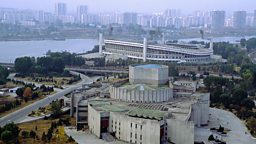
First stop on any tour: The grand monument…
Come morning, visitors to Pyongyang board a coach and begin their tour. The giant statue of former leaders Kim Il-sung, now joined by a twin statue of Kim Jong-il, is a sight of pilgrimage for all North Koreans and, for most visitors to Pyongyang, the first port of call. It is a great offence to refuse to visit the memorial site. Tourists are encouraged to walk up to the statues in silence, often past hundreds of nationals dressed in their finest clothes, and pay their respects with a wreath of flowers.
Tony Pletts, the writer and broadcaster who visited the country, describes the scene: “Kim Il-sung is definitely centre stage: he’s 60 metres high, and the blue sky just sets him off absolutely perfectly - he’s glinting in the morning light. And flanked on either side there are these two enormous sculptures and they’re holding aloft bales of hay, and machine guns. Others are blowing trumpets, people are waving rifles, someone’s throwing a grenade. If you like socialist realist art and Stalinist monuments this is it – this is the one for you.”

…followed by the Tower of the Juche Idea
Another important monument in Pyongyang, on all tour guide agendas, is the Juche Tower. From the top of the tower a tour guide explains that “Juche means self-reliance. Juche is the philosophy created by the great leader Kim Il-sung.”
It is 170m high and resembles Nelson’s column with a big flame on top, which is lit up at night. The flame symbolises North Korean independence and freedom.
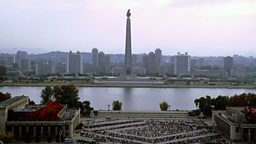
Going underground
Pyongyang has a “spectacular” metro system. One visitor describes how “it’s extraordinarily opulent: it’s nearly the size of the Royal Albert Hall.” Full of huge mosaics and murals and chandeliers, it’s large enough to double as an air raid shelter.
The names of the stations include Glory Station, Victory Station, War Victory, Unification, National Restoration, Bumper Harvest, Renovation and Paradise.

The border with South Korea
Sara Jane Hall states: “no travel in North Korea is complete without a visit to the border with South Korea.” This is the place where communism meets capitalism.
The road down to the border is lined with concrete, which – in the event of an invasion – could be loaded with dynamite and dropped into the road. Travellers visit the pavilion where the 1963 armistice was signed and step into blue, prefabricated huts that have been built straddling the border. Directly outside the windows on the south side of the huts stand South Korean soldiers in dark sunglasses. It’s a tense place.
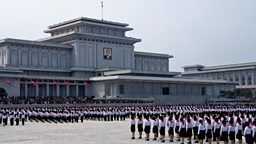
Broadcaster Andy Kershaw described his experience: “It’s one of the most terrifying and dangerous places in the world and one of the most heavily militarised obviously, but for all that it’s so peaceful and so serene. Not entirely silent – birdsong for example – and just in the distance you can perhaps hear South Korean propaganda music being played from giant speakers at the top of massive towers.”
As one tour guide said: “A million men facing a million men on the other side – that’s moving. It’s a very sad place.”
-
![]()
Archive on 4: Travels in North Korea
Despite the view from the west that North Korea is an impenetrable mystery, Sara Jane Hall hears from visitors who are still arriving in Pyongyang airport for business and holiday.
More from BBC Radio 4
-
![]()
The Problem of North Korea
David Aaronovich explores what to do about a nuclear North Korea.
-
![]()
Crossing Continents: Escape from North Korea
Reporting the desperate and dangerous efforts of North Koreans to flee to the South.
-
![]()
12 fascinating facts about dots
Have a gander at these fun facts about the shape that we are, quite simply, dotty about.
-
![]()
How people got Chinese script onto keyboards
The great engineering and linguistic challenge of getting Chinese onto a computer.





